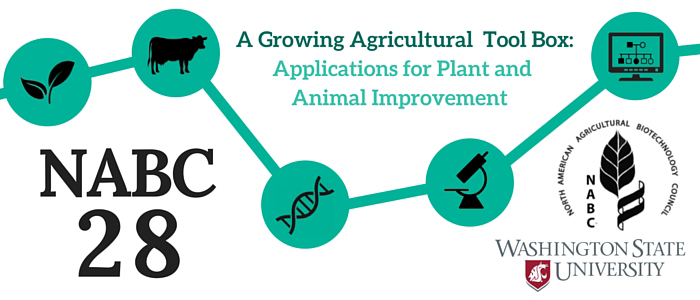NABC 28: A Growing Agricultural Genetic Tool Box:
Applications for Plant and Animal Improvement.
June 1 and 2, 2016
Washington State University
Session 1 Wednesday AM
Coping with copious information
The amount of information being generated in many parts of biology is truly amazing and, unlike data streams in many other areas of science, each bit actually may have significant meaning in determining or deciphering how things work. Communities are being organized around this data and having efficient strategies for saving, accessing and interrogating the data is essential.
Dorrie Main (Washington State University)
The Database Dilemma – Keeping all the data or while strategically working with some
TBD
Session 2 Wednesday AM
Generating and exploiting variation
A major part of agricultural breeding involves bringing desirable variants together in one organism. New genetic and epigenetic strategies have been developed for generating variants and assessing how genes work.
Luca Comai (University of California at Davis)
Understanding and designing the genome of crop plants
Kiran Mysore (Noble Foundation)
Gene function analyses by virus-induced gene silencing and insertional mutagenesis
Sally MacKenzie (University of Nebraska)
Modifying epigenetic behavior in crop plants as a production-enhancing strategy
Session 3 Wednesday PM
Connecting phenotypes to genotypes
Mapping genes that contribute to phenotype has been a major research activity for about a hundred years but the ability to take large genetic and phenotypic data sets and figure out where genes that contribute to polygenic inheritance of complex traits are located is a relatively new capability.
Jared Decker (University of Missouri)
Livestock Genomics: New Approaches For Connecting Basic Biology to Genetic improvement
Carolyn Lawrence (Iowa State University)
Information Management Platform Development for the Genomes to Fields Initiative
Steven White (USDA-Agricultural Research Service, Pullman, WA)
Accelerating genome-to-phenome with FAANG, the Functional Annotation of ANimal Genomes project
Session 4 Wednesday PM
Extending the envelope
Two capabilities now within the category of “we always wanted to know how these things worked” are characterizing the identities and nature of the microorganisms that provide an important component of an organism’s environment and understanding how to deliberately manipulate useful metabolic pathways.
Tim Paulitz (USDA-Agricultural Research Service, Pullman, WA)
Soil and Plant Microbiomes in Agriculture: Going Beyond the Descriptive to Answering Relevant Questions
Larry Forney (University of Idaho)
Seeing the Unseen: approaches to understanding the ecology of microorganisms
Mark Lange (Washington State University)
Modeling metabolism – how to really integrate ‘omics’ data
Session 5 Thursday AM
Phenomics
Because it has become relatively easy to obtain genetic information and because computational methods for finding associations between genetic or phenotypic characteristics in large data sets has improved, gathering large amounts of phenotype information has become a limiting factor for many projects. As a result, developing methods to measure the relevant components of the phenome has become a priority.
Sindhuja Sankaran (Washington State University)
Advanced Sensing Tools and the Future of Phenomics
Edgar Spalding (University of Wisconsin)
Phenotyping maize seed and seedlings using image processing and high-throughput computing
Jeff White (USDA-Agricultural Research Service, Maricopa, AZ)
Field phenotyping basics for adaptation to heat and water deficits
Session 6 Thursday AM
Breeding for agriculture
Implementing a modern breeding strategy using “classical” methods is complex but is potentially much more powerful than it was even a few years ago. DNA markers can be used to follow traits, like disease resistance or components of polygenic inheritance, which can be difficult to assay directly. High throughput phenotypic assays can be used to screen populations and eliminate individuals that are outside of the desired range of parameters. DNA sequencing can be used to verify the presence of specific alleles in selected individuals and to establish identities for IP protection.
Seungho Cho (Monsanto)
Transformation of plant breeding to deliver increased genetic gain
Rollin Sears (Kansas State University)
Wheat Improvement towards 2035: Building on success into the future
Henry Nguyen (University of Missouri)
Next generation genomic tools for soybean improvement
Thursday PM
NABC Council meeting: Where does NABC go from here?
Because the topic of this meeting concerns the future of NABC, Council members and representatives from institutions that might become NABC members are invited to attend.


